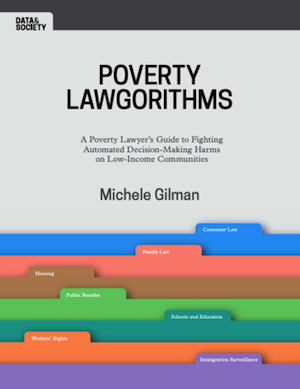A poverty lawyer’s guide to fighting automated decision-making harms on low-income communities
Automated decision-making systems make decisions about our lives, and those with low-socioeconomic status often bear the brunt of the harms these systems cause. This guide has been prepared to help poverty and civil legal services lawyers with the ins and outs of data-centric and automated-decision making systems, so that they can clearly understand the sources of the problems their clients are facing and effectively advocate on their behalf.
The report is organised into six major practice areas: consumer law, family law, housing, public benefits, schools and education, and workers’ rights, with a final section on immigrant surveillance. Lawyers will find useful explanations for technologies relevant to each domain and tips for how lawyers can take action. For example, Gilman explains how facial recognition technology is used in public housing and encourages lawyers to get involved in the legal discussion around the technology, since it’s such a fast-moving legal space.
The guide provides definitions of foundational concepts, shares guiding principles—such as “computers are not magic”—and incorporates reading lists for those interested in taking a deeper dive.
Key takeaways:
- Low-income people and their lawyers need to be a part of the conversation when a government is looking to adopt an automated-decision making system and remain engaged during the integration process.
- Low-income people and their lawyers should work with policymakers who are focused on data privacy and protection to ensure that laws serve everyone, not just elites and industry. These individuals have vast amounts of knowledge and experience to share.
- Legal services lawyers need funding for training and education around automated-decision making systems to better advocate for their clients in court.
- None of the tactics outlined in this report are easy, given an already overloaded plate. It’s important to collaborate with pro bono lawyers and law offices who work in litigation.




